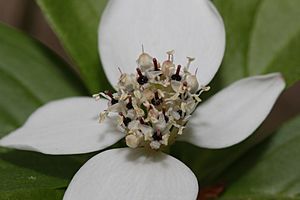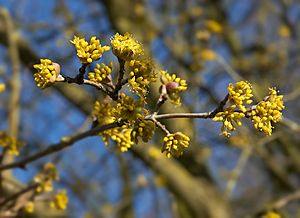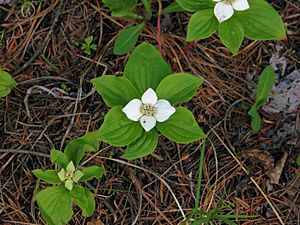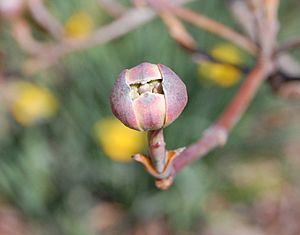Cornus facts for kids
Quick facts for kids Cornus |
|
|---|---|
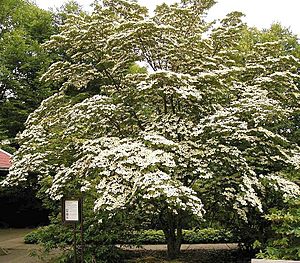 |
|
| Cornus kousa var. chinensis | |
| Scientific classification |
|
| Kingdom: | Plantae |
| Clade: | Tracheophytes |
| Clade: | Angiosperms |
| Clade: | Eudicots |
| Clade: | Asterids |
| Order: | Cornales |
| Family: | Cornaceae |
| Genus: | Cornus L. |
| Type species | |
| Cornus mas |
|
| Subgenera | |
|
|
| Synonyms | |
|
Chamaepericlimenum Hill |
|
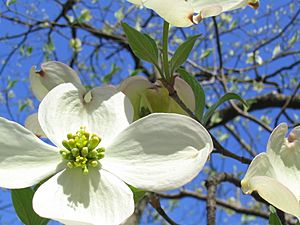
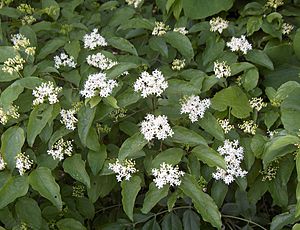
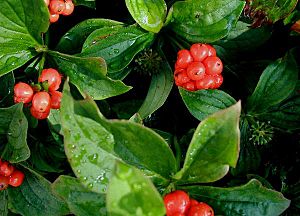
Cornus is a genus of about 30–60 species of woody plants in the family Cornaceae, commonly known as dogwoods, which can generally be distinguished by their blossoms, berries, and distinctive bark. Most are deciduous trees or shrubs, but a few species are nearly herbaceous perennial subshrubs, and a few of the woody species are evergreen. Several species have small heads of inconspicuous flowers surrounded by an involucre of large, typically white petal-like bracts, while others have more open clusters of petal-bearing flowers. The various species of dogwood are native throughout much of temperate and boreal Eurasia and North America, with China, Japan, and the southeastern United States being particularly rich in native species.
Species include the common dogwood Cornus sanguinea of Eurasia, the widely cultivated flowering dogwood (Cornus florida) of eastern North America, the Pacific dogwood Cornus nuttallii of western North America, the Kousa dogwood Cornus kousa of eastern Asia, and two low-growing boreal species, the Canadian and Eurasian dwarf cornels (or bunchberries), Cornus canadensis and Cornus suecica respectively.
Depending on botanical interpretation, the dogwoods are variously divided into one to nine genera or subgenera; a broadly inclusive genus Cornus is accepted here.
Contents
Terminology
The name "dog-tree" entered the English vocabulary before 1548, becoming "dogwood" by 1614. Once the name dogwood was affixed to this kind of tree, it soon acquired a secondary name as the Hound's Tree, while the fruits came to be known as "dogberries" or "houndberries" (the latter a name also for the berries of black nightshade, alluding to Hecate's hounds). Another theory advances the view that "dogwood" was derived from the Old English dagwood (dagwood is a form which is unattested), from the use of the slender stems of its very hard wood for making sharp objects: "dags" (daggers, skewers, and arrows). Another, earlier name of the dogwood in English, is the "whipple-tree". Geoffrey Chaucer uses "whippletree" in The Canterbury Tales ("The Knight's Tale", verse 2065) to refer to the dogwood. A whippletree is also an element of the traction of a horse-drawn cart, linking the drawpole of the cart to the harnesses of the horses in file; these items still bear the name of the tree from which they are commonly carved.
Characteristics
Dogwoods have simple, untoothed leaves with the veins curving distinctively as they approach the leaf margins. Most dogwood species have opposite leaves, while a few, such as Cornus alternifolia and C. controversa, have their leaves alternate. Dogwood flowers have four parts. In many species, the flowers are borne separately in open (but often dense) clusters, while in various other species (such as the flowering dogwood), the flowers themselves are tightly clustered, lacking showy petals, but surrounded by four to six large, typically white petal-like bracts.
The fruits of all dogwood species are drupes with one or two seeds, often brightly colorful. The drupes of species in the subgenus Cornus are edible. Many are without much flavor. Cornus kousa and Cornus mas are sold commercially as edible fruit trees. The fruits of Cornus kousa have a sweet, tropical pudding like flavor in addition to hard pits. The fruits of Cornus mas are both tart and sweet when completely ripe. They have been eaten in Eastern Europe for centuries, both as food and medicine to fight colds and flus. They are very high in vitamin C. However, those of species in subgenus Swida are mildly toxic to people, though readily eaten by birds.
Dogwoods are used as food plants by the larvae of some species of butterflies and moths, including the emperor moth, the engrailed, the small angle shades, and the following case-bearers of the genus Coleophora: C. ahenella, C. salicivorella (recorded on Cornus canadensis), C. albiantennaella, C. cornella and C. cornivorella, with the latter three all feeding exclusively on Cornus.
Uses
Dogwoods are widely planted horticulturally, and the dense wood of the larger-stemmed species is valued for certain specialized purposes. Cutting boards and other fine turnings can be made from this fine grained and beautiful wood. Over 32 different varieties of game birds, including quail, feed on the red seeds.
Horticulture
Various species of Cornus, particularly the flowering dogwood (Cornus florida), are ubiquitous in American gardens and landscaping; horticulturist Donald Wyman stated, "There is a dogwood for almost every part of the U.S. except the hottest and driest areas". In contrast, in England the lack of sharp winters and hot summers makes Cornus florida very shy of flowering.
Other Cornus species are stoloniferous shrubs that grow naturally in wet habitats and along waterways. Several of these are used along highways and in naturalizing landscape plantings, especially those species with bright red or bright yellow stems, particularly conspicuous in winter, such as Cornus stolonifera.
The following cultivars, of mixed or uncertain origin, have gained the Royal Horticultural Society’s Award of Garden Merit (confirmed 2017):
- ‘Eddie’s White Wonder’
- ‘Norman Hadden’
- ‘Ormonde’
- ‘Porlock’
Fruits
The species Cornus mas is commonly cultivated in southeastern Europe for its showy, edible berries, that have the color of the carnelian gemstone. Cornelian-cherries have one seed each and are used in syrups and preserves.
Wood
Dense and fine-grained, dogwood timber has a density of 0.79 and is highly prized for making loom shuttles, tool handles, roller skates and other small items that require a very hard and strong wood. Though it is tough for woodworking, some artisans favor dogwood for small projects such as walking canes, arrow making, mountain dulcimers and fine inlays. Dogwood wood is an excellent substitute for persimmon wood in the heads of certain golf clubs ("woods"). Dogwood lumber is rare in that it is not readily available with any manufacturer and must be cut down by the person(s) wanting to use it.
Larger items have also been occasionally made of dogwood, such as the screw-in basket-style wine or fruit presses. The first kinds of laminated tennis rackets were also made from this wood, cut into thin strips.
Dogwood twigs were used by U.S. pioneers to brush their teeth. They would peel off the bark, bite the twig and then scrub their teeth.
Traditional medicine
The bark of Cornus species is rich in tannins and has been used in traditional medicine as a substitute for quinine. During the American civil war confederate soldiers would make a tea from the bark to treat pain and fevers, and dogwood leaves in a poultice to cover wounds.
The Japanese cornel, C. officinalis, is used extensively in traditional Chinese medicine as shān zhū yú for several minor ailments.
Classification
The following classification recognizes a single, inclusive genus Cornus, with four subgroups and ten subgenera supported by molecular phylogeny. Geographical ranges as native plants are given below. In addition, cultivated species occasionally persist or spread from plantings beyond their native ranges, but are rarely if ever locally invasive.
Blue- or white-fruited dogwoods
Paniculate or corymbose cymes; bracts minute, nonmodified; fruits globose or subglobose, white, blue, or black:
- Subgenus Yinquania. Leaves opposite to subopposite; fall blooming.
- Cornus oblonga.
- Cornus peruviana. Costa Rica and Venezuela to Bolivia.
- Subgenus Kraniopsis. Leaves opposite; summer blooming.
- Cornus alba (Siberian dogwood). Siberia and northern China.
- Cornus amomum (silky dogwood). Eastern U.S. east of the Great Plains except for the Deep South.
- Cornus asperifolia (toughleaf dogwood). Southeastern U.S.
- Cornus austrosinensis (South China dogwood). East Asia.
- Cornus bretschneideri (Bretschneider's dogwood). Northern China.
- Cornus coreana (Korean dogwood). Northeast Asia.
- Cornus drummondii (roughleaf dogwood). U.S. between the Appalachia and the Great Plains, and southern Ontario, Canada.
- Cornus excelsa.
- Cornus foemina (stiff dogwood) Southeastern and southern United States.
- Cornus glabrata (brown dogwood or smooth dogwood). Western North America.
- Cornus hemsleyi (Hemsley's dogwood). Southwest China.
- Cornus koehneana (Koehne's dogwood). Southwest China.
- Cornus macrophylla (large-leafed dogwood; Chinese: 梜椋; pinyin: jiáliáng or jiàliáng). East Asia.
- Cornus obliqua (pale dogwood). Northeastern and central U.S., and southeastern Canada.
- Cornus paucinervis. China.
- Cornus racemosa (northern swamp dogwood or gray dogwood). Northeastern and central U.S., and extreme southeastern Canada.
- Cornus rugosa (round-leaf dogwood). Northeastern and north-central U.S., and southeastern Canada.
- Cornus sanguinea (common dogwood). Europe.
- Cornus sericea (red osier dogwood). Northern and western North America, except Arctic regions.
- Cornus walteri (Walter's dogwood). Central China.
- Cornus wilsoniana (ghost dogwood). China.
- Cornus × arnoldiana (Hybrid: C. obliqua × C. racemosa). Eastern North America.
- Subgenus Mesomora. Leaves alternate; summer blooming.
- Cornus alternifolia (pagoda dogwood or alternate-leaf dogwood). Eastern U.S. and southeastern Canada.
- Cornus controversa (table dogwood). East Asia.
Cornelian cherries
Umbellate cymes; bracts modified, non-petaloid; fruits oblong, red; stone walls filled with cavities:
- Subgenus Afrocrania. Dioecious, bracts 4.
- Cornus volkensii.
- Subgenus Cornus. Plants hermaphroditic, bracts 4 or 6
- Cornus eydeana.
- Cornus mas (European cornel or Cornelian-cherry). Mediterranean.
- Cornus officinalis (Japanese cornel). China, Japan, Korea.
- †Cornus piggae (Late Paleocene, North Dakota)
- Cornus sessilis (blackfruit cornel). California.
- Subgenus Sinocornus. Plants hermaphroditic, bracts 4 or 6
- Cornus chinensis (Chinese cornel). China.
Big-bracted dogwoods
Capitular cymes:
- Subgenus Discocrania. Bracts 4, modified, non-petaloid; fruits oblong, red.
- Cornus disciflora.
- Subgenus Cynoxylon. Bracts 4 or 6, large and petaloid, fruits oblong, red.
- Cornus florida (flowering dogwood). U.S. east of the Great Plains, north to southern Ontario.
- Cornus nuttallii (Pacific dogwood). Western North America, from British Columbia to California.
- Subgenus Syncarpea. Bracts 4, large and petaloid, fruits red, fused into a compound multi-stoned berry.
- Cornus capitata (Himalayan flowering dogwood). Himalaya.
- Cornus elliptica
- Cornus hongkongensis (Hong Kong dogwood). Southern China, Laos, Vietnam.
- Cornus kousa (Kousa dogwood). Japan and (as subsp. chinensis) central and northern China.
- Cornus multinervosa.
Dwarf dogwoods
Minute corymbose cymes; bracts 4, petaloid; fruit globose, red; rhizomatous herb:
- Subgenus Arctocrania.
- Cornus canadensis (Canadian dwarf cornel or bunchberry) Northern North America, southward in the Appalachian and Rocky Mountains.
- Cornus suecica (Eurasian dwarf cornel or bunchberry). Northern Eurasia, locally in extreme northeast and northwest North America.
- Cornus × unalaschkensis (Hybrid: C. canadensis × C. suecica). Aleutian Islands (Alaska), Greenland, and Labrador and Newfoundland in Canada.
Incertae sedis (unplaced)
- †Cornus clarnensis (Middle Eocene, Central Oregon)
Horticultural hybrids
Cornus × rutgersensis (Hybrid: C. florida × C. kousa). Horticulturally developed.
Etymology
Cornus is the ancient Latin word for the Cornelian cherry, Cornus mas. ‘Cornus’ means ‘horn’.
See also
 In Spanish: Cornus para niños
In Spanish: Cornus para niños


